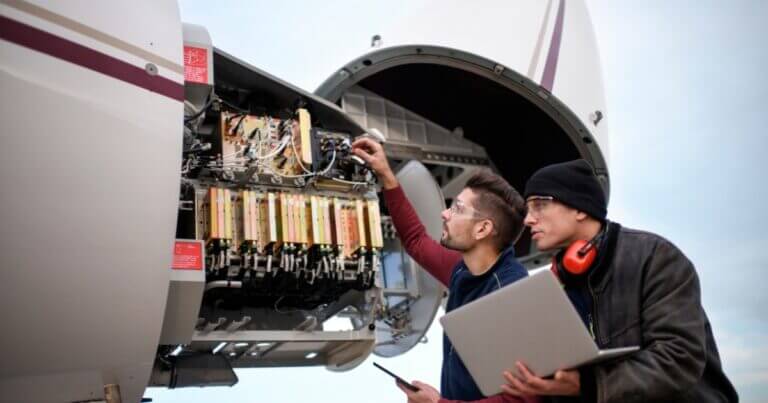Passion should always guide the choices since it is only then that vocation appears in the professions.
It would not differ much from reality if we were to say that many, or almost all branches of aviation are tremendously vocational. Schedules and their delays, inclement weather, and setbacks make working in aviation more like living in aviation.
Aeronautical engineers are no exception. The variety of subjects provides students with the ability to deal not only with projects in the technical field, but also with projects of any kind. In the case of this article, the role of engineers in the aeronautical maintenance sector is explained.
It should be noted that designing an aircraft and its certification process is a complex task that requires a wide range of professionals, resources, and, above all, a long time to go from concept to certification of a new aircraft. Even so, it is just as important to design it correctly as it is to keep it operational and secure. This is where all aircraft maintenance personnel come into play. It should be noted that there are several interdependent departments and an example of these are Engineering, Long-Term Planning, Short-Term Planning, and the Maintenance Control Center (MCC). This article deals with the latter in particular.
What is MCC?
The Maintenance Control Center (MCC from now on) is the nerve center in terms of maintenance of an airline. The department is operational 24 hours a day to monitor the fleet at all times and ensure that it is well maintained. The MCC is part of the Operations Control Center (OCC). This center could be defined as an interdepartmental coordination hub for airlines where daily operations are supervised and controlled in real-time. Although the personnel and number of departments may vary between airlines, in the OCC there are usually departments such as Aircraft Dispatch, Ground Operations, Flight Control, and the MCC, which is usually also included, among others. Physically, the OCC is usually an open room where fast and efficient communication is favored due to the direct dependence between the different areas.
Work of the MCC
We could summarize the work of the MCC at a general level as follows:
- AOG resolution: This is undoubtedly one of the fundamental pillars of MCC. Starting from the beginning, what is an AOG? An Aircraft On Ground refers to the state of an aircraft in which it is unable to fly. Although it may be due to other reasons, an AOG is mostly a situation related to a technical problem. Faced with an aircraft that is declared AOG and therefore unable to fly, personnel must assess the overall situation and make decisions that directly affect operations.
- Defect control and resolution: Just as a car can drive with a blown light, aircraft can fly despite having faults or defects that do not compromise airworthiness. However, there is a rectification interval depending on the importance of the inoperative system or component. In this way, the MCC professionals control the state of the defects, when their repair is planned and how it will be carried out. The MCC is also responsible for developing rectification and troubleshooting plans for those defects that are more complex or repetitive and require in-depth follow-up.
- Elaboration of Work Packages and their supervision: Normally companies have aShort-Term Planning department that plans maintenance tasks. Otherwise, it is the MCC who prepares, plans and supervises the inspections and works.
- Crew support: MCC professionals are in charge of resolving failures or doubts that pilots may have during operations. Whenever the aircraft displays an alert or warning message, the crew will contact MCC to explain the situation and consequently a decision will be made to remedy the problem, either an action by the pilot with the support of the engineer on the other end of the phone or locating a mechanic for on-site assistance.
- Communications to the rest of the company: As mentioned above, the MCC is part of the operations area. This means that personnel in other departments must be aware of the status of the aircraft: limitations, aircraft out of service or delays due to technical problems.
- Real-time monitoring of the fleet: As noted above, it is necessary for personnel to know the status of the fleet on an up-to-date basis. For this reason, the team has software adapted to your needs. There are programs developed to keep track of flights, maintenance tasks and planning, and others that let you know the status of each aircraft wherever it is. The latter is one of the most interesting since it makes it possible to anticipate maintenance actions and take timely action even when the aircraft is in the air.
It should be noted that this position is also performed by aeronautical maintenance technicians with extensive knowledge of the aircraft. There are MCCs composed exclusively of technicians, others only of engineers, and some are mixed. The composition depends solely on the company’s policy and needs.
What does it take to work as an MCC?
The MCC is a position of great responsibility and, consequently, the staff is under pressure during the working day. As mentioned above, decisions must be made with limited options and short time intervals. This implies that, when a problem appears in the aircraft, all possible options must be analyzed in detail (e.g. a change of aircraft, trying to solve the failure with the action of the crew or finding assistance at the airport). Likewise, the available resources must be evaluated depending on where the aircraft is located, all without compromising safety, always within insurmountable margins. In order to get professionals well adapted to this environment, it is convenient that the person knows the aircraft and its systems, the operating procedures of the airline, the structure of the maintenance organization, knowledge of the documentation and its completion, etc… These skills are achieved through courses (some of them recurrent) and specific training. On the other hand, there is the other aspect, the capacity of each individual to tolerate stress, to carry out several issues simultaneously, and to prioritize tasks. This last part, perhaps more personal, is the one that is initially more difficult to develop and put into practice.
You may also be interested in how to obtain an aeronautical maintenance course.
In short, the position of MCC, like other departments, is of vital importance in the day-to-day running of the operation. It requires qualified personnel trained in the procedures to act quickly and effectively. This allows that, regardless of who sits in the position controlling operations, decisions are made based on the same standards.






